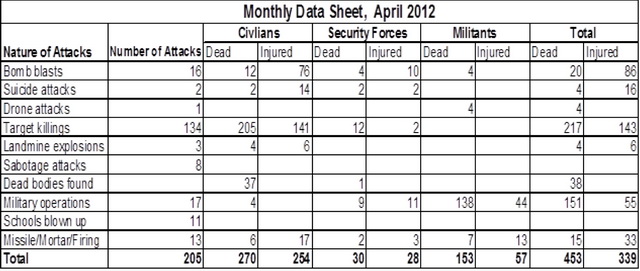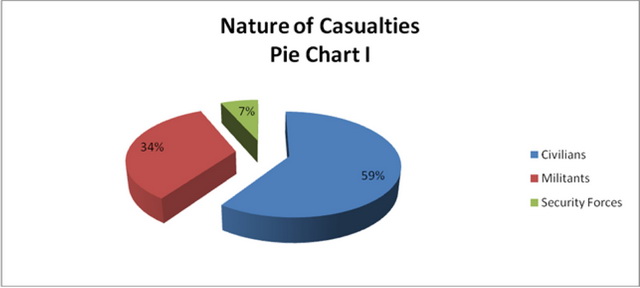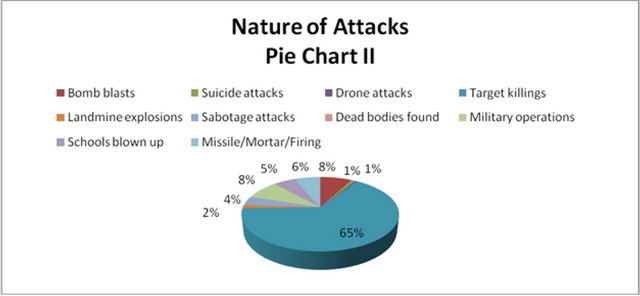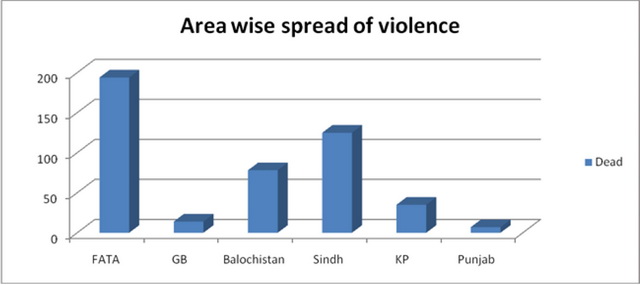Violence of various kinds, involving diverse actors, continued to undermine security and stability in Pakistan during the month of April. Federally Administered Tribal Areas (FATA) again topped in the number of violent acts, while Karachi (Sindh), surprisingly occupied the second place, replacing Khyber Pakhtunkhwa (KP), which usually records higher number of killings than Karachi. It is because of the ongoing spree of target killings ´ both ethnic and political – in Karachi, the largest metropolis of Pakistan, Karachi, which has been rocking the city since the last week of March. The data collected through different sources suggests that 453 people lost their lives in 205 incidents of violence across the country (for details see data sheet). The overall level of violence was down in comparison to March, when 639 people perished to various acts of violence, which also left some 339 people injured.
A concise look into the nature of fatalities of actors involved suggests that the defenseless civilians bore the brunt of hostilities across Pakistan during the current month. In March, militants were at the receiving end and suffered a big number of causalities. As noted in pie chart I below, civilians accounted for almost 59 percent of the total dead. The sole reason for this shift is the ongoing ethno-political violence in Karachi, where large numbers of civilians (political workers belonging to the ethnic Muttahida Qaumi Movement ´MQM and the ethnic Pakhtun Awami National Party – ANP) are becoming the target of turf wars between the two parties, primarily for political influence and territorial control in the commercially crucial city on the Arabian Sea. Militants accounted for some 34 percent of the total loss of lives. While seven percent causalities were of security forces and these were mostly recorded in insurgency-hit areas of KP, FATA and Baluchistan. Furthermore, during the current month, only one CIA operated drone strike was reported in North Waziristan Agency (FATA), which resulted in the killing of four suspected militants. This is a very unusual development given the fact that missile strikes off pilot-less predators have been the choicest weapon under the Obama administration. Tensions with the United States over continued suspension of food, fuel and military supplies via Pakistan after the Salala Check post attack in the Mohmand border region in November appear to be the major reason for a decline in the drone strikes. Meanwhile, carrying on their subversive and sabotage campaign directed against the state utility infrastructure, militants blew up 11 government schools in different parts of FATA and KP during the course of month. Also, eight acts of sabotage were reported in different parts of Baluchistan and Karachi, where miscreants blew up gas pipelines, power pylons and torched vehicles.
Based on the available statistics on the instruments of violence, one finds that target-killing was the principal tool deployed against rivals. The pie chart II below depicts that target killings accounted for a staggering 65 percent of the total dead i.e some 217 people were shot dead across Pakistan in 134 incidents. Karachi topped in this tool of violence with as many as 92 persons falling victim to the rivals– bullets. Meanwhile, military vs. militants– clashes were the second major cause of deaths, as 151 people were killed, including 138 militants and nine security forces personnel. During the course of the month, some 38 dead bodies were also recovered across Pakistan, most of them recorded in Karachi. The fourth major cause of violence was bomb blasts. Among bomb blasts, improvised explosive devices (IEDs) and road side bombs killed most of the people. Likewise, two (one percent of total violent tactics) suicide attacks killed four people, and both of the attacks were reported in the familiar terrain of KP and FATA, the hotbed of war on militancy.
Moreover, looking at the ferocity of violence in different areas of the country, one finds that militancy stricken areas of FATA and Karachi, the hotbed of urban ethno-political violence suffered most of the violence during the month under review. As bar chart below underlines that almost 319 people were killed in the said regions in different circumstances. And it accounted for 78 percent of the total killings across the country during April, while 78 persons were dead in Baluchistan, some 40 percent among them being members of the minority Shia Muslim community. Unlike the previous month, violence dramatically subsided in KP province and only 35 people were reportedly killed as a result of different violent incidents.
Furthermore, the specter of sectarian violence continued to take its toll on the Shia Hazara community based in Quetta (Baluchistan) as well as in Gilgit-Baltistan (GB), northern Pakistan, where attacks on the Shia community disrupted life for several weeks. In case of Baluchistan, 28 Shia men were butchered in what appeared to be another act of organized target-killing and bomb blasts allegedly by the majority Sunni extremist organizations, most importantly, the outlawd Lashkar-e-Jhangvi (LeJ) . Meanwhile, 14 people belonging to Shia and Sunni communities based in GB were shot dead as a result of sectarian violence, which is gripping the area since February 2012, when unknown militants killed 18 Shia Muslims near Chilas, while they were on their way to Gilgit from Rawalpindi. Also, four Shias were gunned down in Karachi. In total, 48 Shias were killed in as many as 14 violent incidents across Pakistan during April.
As a whole, all kinds of violence – ethno-political to religio-political to nationalistic separatist subversion ´ loomed large on the regions mentioned above during April, also a reminder of the mid 1990s, when a massive wave of sectarian and ethno-political violence had rocked Karachi and central Pakistan. This wave of violence consumed several thousand, largely shia Muslims and political workers in Karachi. Even a cursory look suggests that Pakistan is finding difficult to get a handle on violence, particularly the militant campaign against shia Muslims and the inter-party rivalry in Karachi that has held large parts of the country economically most important city. Political patronage of militant groups , usually armed wings of political and religio-political parties stands out as a major reason for the continued spate of violence.
Sources
- The News
- Dawn
- The Express Tribune
- Pakistan Today
- Daily Times
- The Frontier Post
- Jang (Urdu)
- Daily Mashriq (Urdu)
- Aaj (Urdu)
- Baluchistan Times




